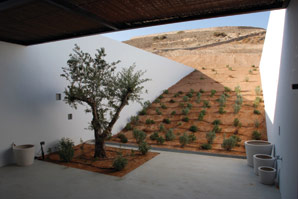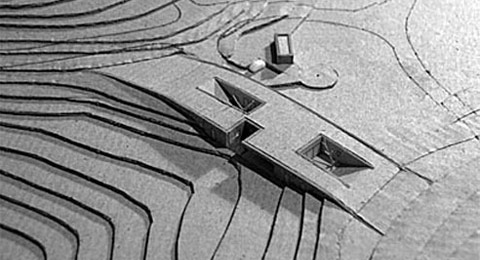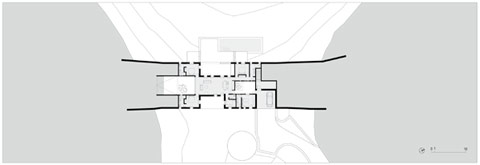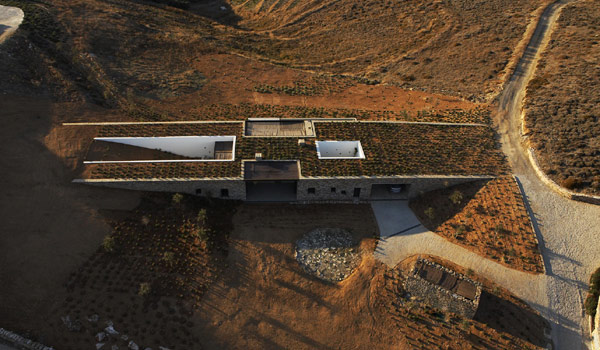Lokacija: Ostrvo Antiparos, Kikladi, Grčka
Arhitekte: decaARCHITECTURE: Alexandros Vaitsos, Carlos Loperena, Elena Zabeli, Kyle Gudsell, Katerina Chryssanthopoulou
Konstruktivni inženjeri: KYMA / Manos Kyriazis
Mašinski inženjeri: TEKEM / George Kavoulakos
Izvođač: Kataskevastiki Topometriki Parou ABETE / Nikos Kaggelis
Pejzažna arhitektura: Doxiadis+ / Thomas Doxiadis
Klijent: Oliaros SA (AntiparosDesignProperties)
Završetak radova: 2008.
Fotografije: Erieta Attali, Ed Reeve, Julia Klimi, decaARCHITECTURE
 Projekat kuće predstavlja odgovor na specifičnu topografiju terena i na tehnike pripitomljavanja zemljoradničkih oblasti koje su u prošlosti oblikovale pejzaž ostrva.
Projekat kuće predstavlja odgovor na specifičnu topografiju terena i na tehnike pripitomljavanja zemljoradničkih oblasti koje su u prošlosti oblikovale pejzaž ostrva.
U prošlosti, kameni zidovi koji su koristili u poljoprivredne svrhe predstavljali su jedine ljudske intervencije u pejzažu. Zidovi su imali funkciju da zadrže zemlju čime je omogućeno da se strm teren koristi u vidu niza obradivih platoa.
Danas, Kikladska ostrva doživljavaju transformaciju usled potpuno drugih faktora – potrebe za izgradnjom kuća za odmor. Projekat se oslanja na ideju kamenih zidova kako bi ostvario veštački pejzaž koji je ujedno i ruralan i prilagođen nameni.
Okolni teren ima oblik sedla i predstavlja mesto na kome se susreću dve padine. Duž ose sever-jug uzdižu se dva brda, dok u pravcu ose istok-zapad nagib opada i otvara se pogled ka moru. Dva dugačka kamena zida premošćavaju brda omogućavajući formiranje objekta unutar zidina, ujedno zadržavajući kontinuitet pejzaža koji se prostire iznad. Ova jednostavna strategija zamagljuje ivice kuće i čini njenu masu neprimetnom u okviru šireg horizonta ostrva.
Prisustvo kuće otkrivaju četiri dvorišta usečena u teren. Ova dvorišta dele životni prostor u pet enterijerskih celina. Rezultat je kuća zaštićena od elemenata okruženja, ali sa dosta prirodnog svetla i sa dubokim vizurama, koja ima kompaktan i bogat odnos prema svom okruženju.
Location Antiparos Island, Cyclades, Greece
Architects decaARCHITECTURE: Alexandros Vaitsos, Carlos Loperena, Elena Zabeli, Kyle Gudsell, Katerina Chryssanthopoulou
Structural Engineers KYMA / Manos Kyriazis
Mechanical Engineers TEKEM / George Kavoulakos
Contractor Kataskevastiki Topometriki Parou ABETE / Nikos Kaggelis
Landscape Architects Doxiadis+ / Thomas Doxiadis
Client Oliaros SA (AntiparosDesignProperties)
Completion 2008
Photographers Erieta Attali, Ed Reeve, Julia Klimi, decaARCHITECTURE
The name of the house itself, Aloni, refers to the remains of a crop-harvesting circle that was found and preserved as part of the agricultural past of the site.
The design of the house is a dual response to the particular topography of the site and to the rural domestication techniques that in the past shaped the raw ‘Cycladic island’ landscape.
In the past, dry-rubble stone walls domesticated the land for agricultural purposes and were the most prominent man-made interventions in the landscape. The walls retained earth and transformed a steep topography into a series of arable plateaus.
Today, the Cycladic islands are being reshaped by a very different force: the demand for holiday homes. The design uses the precedent of earth-retaining stone walls to create an artificial landscape that is both rural and domestic in use.
The site is a natural saddle where two slopes meet. In the North-South axis the slope rises between two hills while in the East-West axis the slope drops, opening to the sea views. Two long stone walls bridge the hills allowing the house to nestle in the space within while maintaining the continuity of the landscape which flows over it. This simple strategy blurs the edges of the house and makes its mass imperceptible within the broader skyline of the island.
The presence of the house is revealed by the four courtyards carved into the flowing landscape. The courtyards separate the living spaces into five interior areas, an arrangement which resembles the fifth side of a dice. As a result, the house is protected from the elements, yet is full of natural light, generous views and a compact but rich relationship to its setting.









